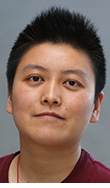Ph.D. student’s team pitches idea on national innovator TV show
In front of a national TV audience and a panel of celebrity judges, Kai Wu, a Texas A&M [Urban and Regional Sciences Ph.D.] (http://laup.arch.tamu.edu/academics/graduate/ursc/) student, demonstrated [SwimART] (http://swimart.co) , a tiny submersible computer she and a team of entrepreneurs developed to enable competitive swimmers to monitor their statistics in real time without interrupting their stroke.
Their [pitch] (https://www.americasgreatestmakers.com/team/swimart/) was part of the first televised round of “America’s Greatest Makers,” a spring 2016 TBS show in which 24 teams of innovators and entrepreneurs vied to create the “next big thing” in wearable tech.
The SwimART group's introductory [video] (https://www.americasgreatestmakers.com/team/swimart/) was filmed, in part, at various locations on the Texas A&M University College Station campus, including scenes shot at the Student Recreation Center pool, the College of Architecture’s woodshop and Langford Architecture Center atrium.
Although Wu’s team advanced through several preliminary rounds, the pitch marked the end of their contest journey.
“It was disappointing,” said Wu, who, like the rest of the SwimART development team, is a swimming enthusiast. “I think the avid swimming community, the market we’re targeting with SwimART, was too small to keep us in the contest.”
As they developed the device, she collaborated by video chats and email with her three New York City-area team members, who include a software architect and a technology and business developer.
The device they created, which fits on an ordinary pair of swimming goggles, includes a tiny rectangular screen that extends in front of a swimmer’s eye. The screen displays the swimmer’s speed, number of calories burned, the number of laps swum and the accuracy of the swimmer’s stroke style.
In a preliminary “America’s Greatest Makers” round, Wu and her teammates were flown to San Francisco by contest organizers to present a model of the device, which Wu designed and created on a College of Architecture 3-D printer, to [Intel] (http://www.intel.com/content/www/us/en/homepage.html) CEO Brian Krzanich and the show’s producers.
After the presentation, the team was invited to a contest-sponsored tech camp in San Francisco, where they created a working prototype with an operating system that includes an Intel 3 module and an accelerator and gyroscope working in tandem to produce the data displayed on the device’s screen.
Some of the teams were sponsored by companies or included members who developed their ideas during their work hours, but Wu’s team members juggled their time to develop SwimART along with other commitments, such as university teaching positions, family responsibilities, full-time jobs, or in Wu’s case, Ph.D. studies and part-time research duties at the [Hazard Reduction and Recovery Center] (http://hrrc.arch.tamu.edu) .
The end of the contest doesn’t mean the end of SwimART. Wu and her colleagues are planning to seek crowdfunding to continue to develop the device and bring it to market, she said.
Although her team’s presence in the televised portion of the contest was short-lived, Wu said she considered the experience to be another element of her education.
“It was like an additional class for me, and gave me an opportunity to work with other people in other fields to reach a goal,” she said.
School, she added, isn’t necessarily limited to classes. “Developing projects like this is an education too,” she said.
Her SwimART teammates are Jianping Huang, software architect, [AvePoint] (http://www.avepoint.com) ; Li Liu, technology and business development manager, [Center for Biotechnology] (https://synaptic.bio/organizations/centerforbiotechnology) , and Zhongwei Liu, materials scientist, [Chemcubed] (http://www.chemcubed.com) .
They were among thousands of teams that initially submitted their ideas to organizers of the contest, hosted by Intel, one of the globe’s largest semiconductor chipmakers, United Artists Media Group and Turner Broadcasting System.
Tags
- competitions
- entrepreneurship
- events
- fabrication
- feature
- interdisciplinary
- landscape architecture & urban planning
- partnerships
- technology
Related Posts

13 outstanding alums share how college aided their success
Students help firm build canned food dinosaur sculpture
Viz grad tells how Disney team used GIS to create 'Zootopia'

College names 2012 Outstanding Alumni

Nigerians receive LAND students’ plan for medical city
Follow Us
Facebook Twitter Vimeo Youtube Flickr RSS
Recent Posts

Planning prof heads study of disaster housing aid

A message from the dean

Former student remembered as expert planner

Leading educator named new head of Architecture Dept.








_thumbnail_small.png)
